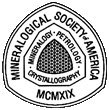 |
The Mineral Identification Key |  |
 |
The Mineral Identification Key |  |
Hardness is a mineralogical term denoting how resistant a mineral is to being scratched. It should not be confused with a mineral’s overall "toughness." (Diamond is the hardest known mineral, but it has a perfect cleavage and breaks easily along that cleavage.) Relative Hardness is used in identification by comparing the hardness of the mineral to that of items with known hardness. Mohs Scale of Relative Hardness is used, and is presented here with the addition of a few common materials of known hardness added:
1: Talc (softest) 2: Gypsum 2½: Fingernail 3: Calcite or Copper Penny 4: Fluorite 5: Fluorapatite 5+: Pocket Knife 5½: Window Glass
6: Orthoclase (or Microcline) 6½: Steel File 7: Quartz 8: Topaz 9: Corundum 9-9½: Carborundum 10: Diamond (hardest) One tests for Relative Hardness by scratching the surface of a crystal or cleavage face with an item of known hardness – and vice versa, scratching the item of known hardness with a sharp point, edge, or grain of the mineral being tested. Whenever possible, the test should be done both ways – first trying to scratch the sample, then trying to scratch the item of known hardness, such as scratching a crystal face with a knife point and then trying to scratch the knife blade with the point or a sharp edge of the crystal. Since some minerals may leave a powdered streak on the item being scratched (or the known hardness item may leave a streak on the sample) one must rub the "scratch" with a finger to see if it is really a scratch or just a powder streak that rubs off. If a mineral produces a powder streak on the item being scratched then it is probably softer than that item. (Conversely, if the item leaves a streak on the sample it is softer than the sample.)
Since the "scratch test" is very important to the identification of minerals every effort should be made to get a positive result – be sure that the correct hardness is determined. With some samples, it may take several tries before one can safely conclude the sample’s hardness.
Return to Key: Step 2 Return to Key: Step 3 Return to Key: Step 5 Return to Step 7 Return to Step 10 Return to Step 14
[ Table of Contents ] [ Introduction ] [ Identification Kit ] [ Mineral Properties ] [ Environments & Associations ] [ In Conclusion ] [ The Mineral ID Key ]